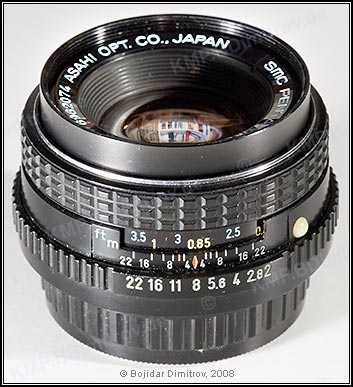M 50/2

General Description
| Product Information | |
|---|---|
| Exact Name | smc PENTAX-M 1:2 50mm |
| Color | black |
| Year of Introduction | 1979 |
| Catalog Number | 20677 |
| Sold with Hood | — |
| Sold with Case | — |
Technical Specifications
| Optics | |
|---|---|
| Optical Formula | 5 elements in 5 groups |
| Aperture Range | f/2 ~ f/22 |
| Number of Aperture Blades | 6 |
| Minimum Focusing Distance | 0.45 m |
| Maximum Magnification | 0.15 X |
| Mechanics | |
| Filter Diameter | 49 mm |
| Maximum Diameter | 63 mm |
| Length | 31 mm |
| Weight | 160 g |
| Accessories | |
| Cap | plastic clip-on cap, 49 mm |
| Fitting Hood(s) | screw-on hood: PH-R49 clip-on hood: PH-S49 screw-on hood: RH-R49 |
| Fitting Case(s) | dedicated hard case: exact name unknown |
Subjective Evaluation
This lens is not very exciting. It was the standard lens that Pentax sold with all their M-series bodies, so it is very abundant. The lens was optimized for low-cost production and is optically not quite as good as the slightly more expensive M50/1.7 or A 50/1.7. Still, if you’ve never used a prime lens, you will be amazed at the quality of images you get with one of these "cheap lenses".
However, there is one interesting thing about the M 50/2. In early 2007 Fabio Cittadini noticed that some M 50/2 lenses featured a linear aperture lever — just like the newer SMC-A lenses. Fabio Cittadini and Dario Bonazza were able to track down several M 50/2 and compiled the following list of differences:
| Early Lens | Late Lens | |
|---|---|---|
| Example Srial Numbers | 4327532, 4455263 | 4991229, 4991994, 5838189 |
| Diapfragm actuator displacement proportional to | aperutre diameter | aperture area |
| Lettering on front ring | ASAHI OPTICAL CO. | ASAHI OPT. CO., JAPAN |
| Lettering on lower side of aperture ring | MADE IN TAIWAN | none |
| Lettering on front cap | ASAHI PENTAX | PENTAX |
| Weight | 165 gram | 138 gram |
| Aperture ring | 49 teeth | 59 teeth |
| Aperture-blades ends | visible from back | visible from front |
| Rear barrel details fixed/moving | 3/5 rings | 5/3 rings |
| Aperture simulator | chrome | black |
| locking notch | U-shaped | elliptical |
We could assume that Pentax ran out of parts for the old-type M 50/2 lens and when they needed a new batch of lenses, they simply used parts from the newly developed A 50/2 lens and a mount without lens contacts. There is one more example of this practice — the M 28/2.8 lens.